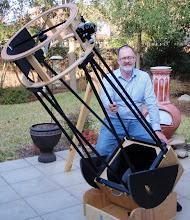A night for observing
Friday, the sky in San Antonio was partly to mostly cloudy, with a forecast for continued partly cloudy. I decided to drive the 80 miles west to Garner State Park for some hammock camping. I took my astronomy gear on the chance that the skies would clear. My main goal was to do a practice sweep of the Virgo Cluster for an upcoming Messier Marathon. I had previously tried to see the galaxies in the cluster from my urban skies in Helotes (TX), but the mag 4 observing had not proved to be quite good enough for a newbie observer.
I set up in a campsite in the Shady Meadows area (#127) and staked out a spot across the road for my observing site. With me, I had "Texas" my Orion XT10 10 inch dobsonian and a pair of 10x50 binoculars. I had preprinted a set of Messier Marathon charts and had them in a notebook. All my finding would be with a TelRad finder. I have no finder scope. I also wanted through the night to pick up a few more Messier objects on my binocular list.
Going in, my Messier count stood at 75 previously observed Messier objects and 38 on the Binocular side.
The sunset was pretty, but there were still a lot of clouds around. But as the twilight gathered, the clouds began to clear out and I was left with a great view of the milky way. There was just a tiny dome of light to the east, though I don't know where that originated. My view was restricted below about 20 degrees to the south and about 10 degrees in other directions.
I warmed up on the open clusters in Auriga and Gemini, took a look at Venus which was just on the waning side of first quarter, then began seeing what I could see.
It was still pretty light in the West, so I turned to the Andromeda cluster and was easily able to pull out all three galaxies. M33 was just on the other side of the Andromeda pointers.
I looked west as it became dark and realized that I could still pick out M15 in Pegasus, but I did not see anything else worth finding West of the beginning of the Messier Marathon list.
So I began the task of working my way through the Messier marathon order with M74 and 77. I have run the fall Messier list pretty well previously, but I did discover a couple that had fallen through the cracks. I worked through the Puppis and Monoceros clusters, forgetting to pick up the two Cancer clusters before hitting the sack for a few hours of sleep.
After I laid down in my warm hammock (no tarp up tonight - I wanted to watch the sky) clouds rolled in an completely obscured all the stars. A north wind began to blow more than it does most Texas nights and the temperature dropped about 20 degrees from 50 to about 30.
Just in time, probably about 3 AM, the clouds rolled away again, revealing Leo almost overhead. Saturn makes the constellation look a little strange this year.
I put on my coat and balkava and went back to the scope. I ran the Leo Galaxies and the UMA and CVN area. Then I went to work on the Virgo Cluster. That proved to be a lot of fun. I was able to run the whole cluster first time. A set of eyepiece diagrams made this MUCH easier after I had picked up 49 and 61. I began with M98 and was able to run the whole crowd without a hitch. I then picked up the HYA clusters and galaxy and looked East. I was able to pick up M5, 13 and 92 just above the trees.
I saw that the fan of Scorpius was visible just above the horizon to the East and looked and again found comet Lulin. It was a lot clearer than it is from my backyard in Helotes.
By now I was just about frozen and I retreated back to sleep for a little nap. I got up 45 minutes later, still cold, and looked around a little. Not much new was up above the horizon. I could see Vega through the trees, but the ring nebula was only just above the horizon really through trees. I looked at what I had available and went back to bed, sleeping til sunrise.
Over the evening I was able to log 69 objects. The whole VIR cluster was new for my Messier list and by the end of the night I am only 6 Messier objects from logging the whole list. My Binocular Messier list is only 4 from the magic number of 50 to report to the Astronomical League.
It was a successful trip. The clouds were much better than I ever dreamed they would be. I probably should have had a heavier coat and a pair of gloves. Using the Telrad and finder charts worked like a charm.
Seeing the comet was an added bonus.
Dark Skies,
Risk
Monday, January 26, 2009
Subscribe to:
Posts (Atom)

